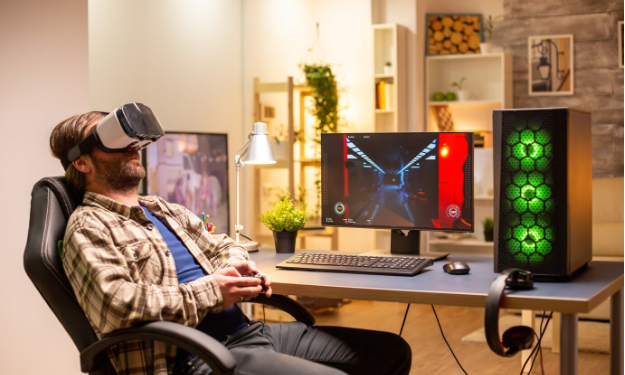In the ever-evolving landscape of technology, virtual reality (VR) has emerged as a groundbreaking force, transforming various industries. One area where its impact is particularly pronounced is gaming. Virtual reality in gaming has redefined the way players interact with digital worlds, offering immersive experiences that were once thought to be the stuff of science fiction. In this article, we will delve into the transformative impact of virtual reality on the future of gaming, exploring the key developments, benefits, and challenges associated with this burgeoning technology.
Immersive Gameplay Experience
Virtual reality brings an unprecedented level of immersion to gaming. Traditional gaming setups involve a player interacting with a screen, but VR takes it to the next level by placing the player directly into the virtual environment. This shift in perspective creates a sense of presence, making the situs slot gacor gaming experience feel more real and tangible. Whether exploring fantastical realms or engaging in intense combat scenarios, players find themselves physically and emotionally connected to the game in ways previously unimaginable.
Realistic Graphics and Environments
One of the most notable impacts of VR on gaming is the enhancement of graphics and environments. Virtual reality headsets offer high-resolution displays and advanced tracking systems that enable realistic rendering of digital worlds. This heightened visual fidelity adds a layer of authenticity to the gaming experience, allowing players to appreciate intricate details, lifelike textures, and dynamic lighting. As VR technology continues to advance, we can expect even more stunning visuals that blur the lines between the virtual and real.
Revolutionizing Gaming Interaction
Traditional gaming interfaces involve controllers and keyboards, limiting the range of interactions. Virtual reality, however, introduces a new era of intuitive and natural interactions. VR controllers, often designed to mimic real-world hand movements, allow players to reach out, grab, and manipulate objects in the virtual space. This not only enhances the sense of immersion but also opens up new possibilities for gameplay mechanics. From wielding a sword to solving puzzles with hand gestures, VR redefines the way players engage with virtual environments.
Social Gaming in Virtual Reality
While gaming has historically been a solitary activity, virtual reality introduces a social dimension to the experience. Multiplayer VR games enable users to interact with each other in real-time, regardless of physical distances. This social aspect adds a new layer of engagement, fostering a sense of community among players. Virtual reality chat rooms and shared gaming spaces create opportunities for collaborative pg slot gameplay, turning gaming into a more social and shared experience.
Health and Fitness Integration
Virtual reality in gaming extends beyond entertainment, incorporating elements of health and fitness. VR fitness games and applications encourage physical movement, turning gaming into a more active and dynamic experience. From dancing to sword fighting, these immersive fitness experiences provide a fun and engaging way for players to stay active. This convergence of gaming and fitness aligns with the growing emphasis on healthy lifestyles, making virtual reality a potential tool for promoting physical activity.
Challenges and Considerations
While virtual reality has undoubtedly revolutionized gaming, it comes with its set of challenges. One significant hurdle is the cost associated with high-quality VR setups. Premium VR headsets and compatible hardware can be expensive, limiting widespread adoption. Additionally, concerns about motion sickness and discomfort during extended use have been raised, prompting ongoing efforts to improve comfort and reduce potential side effects. Overcoming these challenges will be crucial for the continued success and mainstream acceptance of virtual reality in gaming.
Future Trends and Innovations
The future of gaming in virtual reality holds exciting possibilities. As technology advances, we can anticipate even more immersive experiences, enhanced graphics, and innovative gameplay mechanics. The integration of artificial intelligence (AI) and machine learning is likely to play a pivotal role in creating dynamic and responsive virtual worlds. Moreover, advancements in haptic feedback technology may further heighten the sense of touch, adding yet another layer to the immersive slot88 gaming experience.
Conclusion
In conclusion, the impact of virtual reality on the future of gaming is profound and multifaceted. From immersive gameplay experiences to realistic graphics, VR has redefined how players interact with digital worlds. The social dimension, health and fitness integration, and ongoing innovations in technology contribute to a dynamic landscape where virtual reality continues to shape the gaming industry. While challenges exist, the potential for transformative experiences and new possibilities make virtual reality an exciting frontier for both developers and gamers alike. As technology continues to advance, we can only imagine the incredible gaming landscapes that virtual reality will unveil in the years to come.








































